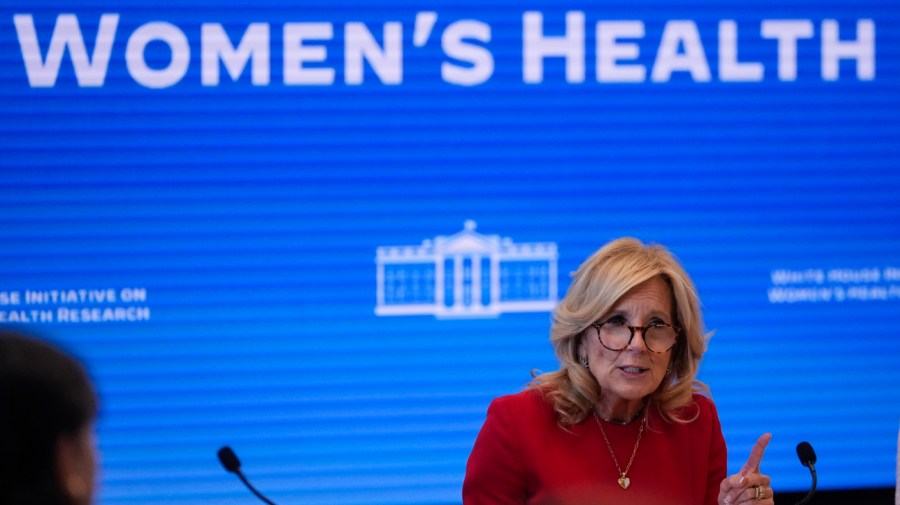
Between Mother’s Day, National Women’s Health Week and the newly declared Maternal Mental Health Awareness Week, May is a month to celebrate women. This year, American women can celebrate a new focus on and investment in a better understanding of our health.
But even amid progress, there’s a long way to go.
The Biden administration recently dedicated $100 million in funding for women’s health research through the federal ARPA-H Sprint for Women’s Health. This funding is focused on five specific areas, from ovarian and brain health to women’s health at home, chronic pain and new scientific models for studying sex differences. Plus, the call for proposals allows bidders to offer ideas or initiatives that don’t fit into those areas but would represent a revolutionary breakthrough in women’s health.
The ARPA-H funding highlights the major gaps in women’s health research and development and makes a dent in filling some of those gaps. But in the grand scheme of things, $100 million is a relatively small amount, especially divided across five or six focus areas and in light of historically paltry levels of funding for women’s health research.
This is a good metaphor for where we are with women’s health — much better off than where we have been historically, but still nowhere near where we need to be.
For most of history, women were simply not included in the clinical trials conducted to understand diseases and identify new treatments. As a result, scientists lacked (and often still lack) knowledge of how sex differences affect disease presentation, progression and treatment.
The NIH Revitalization Act of 1993 established guidelines requiring that National Institutes of Health-funded clinical trials include women. More recently, the 21st Century Cures Act, enacted in 2016, required researchers to submit data specifically analyzing sex/gender variables. In 2017, the NIH updated its policy on the inclusion of women and minority populations to require researchers to submit valid analyses to ClinicalTrials.gov.
You would think that the NIH — the largest public funder of biomedical and behavioral research in the world — requiring inclusion of women would eventually have a positive impact. Unfortunately, we just aren’t there yet.
In 2020, only 11 percent of the annual NIH budget went toward women’s health research, which leaves ample opportunity for improvement.
A 2021 study showed that research funding consistently favors conditions that affect men more than women. Conditions that uniquely affect women, such as fibroids and endometriosis, remain sorely under-studied. Women with heart disease and even heart attacks are still often overlooked and underdiagnosed. And though we can finally speak more openly about menstruation and menopause thanks to cultural shifts and movements to acknowledge these cycles of women’s health, research studies into these domains don’t even get their own line items in NIH reporting.
The picture isn’t entirely bleak. Meaningful advances in preventing and treating conditions that affect women have saved millions of lives.
According to the Centers for Disease Control and Prevention, HPV vaccines, first recommended in 2006, have reduced HPV infections — the cause of most cervical cancers — by more than 80 percent among teen girls and young women. Rates of new cervical cancer cases and rates of death from cervical cancer have both declined in the last 20 years. Similarly, rates of breast cancer deaths have steadily declined.
But to truly move women’s health forward to the level all women deserve, we must do more.
We need to acknowledge and study the role that hormones and hormonal changes play in how women present and experience symptoms of disease, how women respond to treatments, and the long-term ramifications of diseases and their treatments. Though every disease should be examined through this lens, researchers should especially focus on conditions that are particularly prone to hormonal influence, such as menopause, cancer and brain health.
Studying these issues is essential, but it’s not enough just to chip away at knowledge gaps. We must also disseminate lessons learned from that research in ways that healthcare providers and consumers can access and absorb. Rapid distribution of new findings to providers will improve clinical practice, and plain-language communications can help empower women to educate and advocate for themselves to ensure they benefit from the latest research.
All women deserve accessible, culturally relevant, digestible health information to guide their informed decisions about their own health.
The theme of 2024’s Women’s Health Week focuses on “empowering women to take charge of their health journeys.” This year, in lieu of slogans about inclusion, let’s get to the actual work of improving women’s health with even greater funding and improved communications about real results.
And the moms in your life might also appreciate some flowers — or at least a call or a text.
Martha Nolan is a senior policy advisor at Healthy Women.














